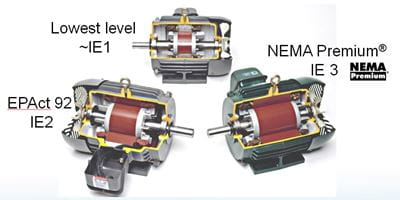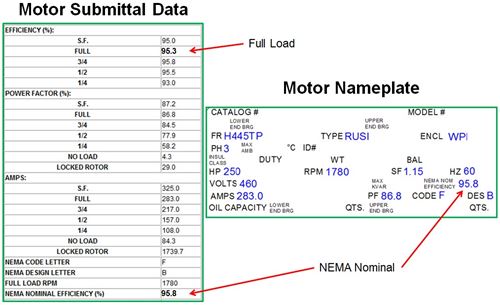Beginning June 1, 2016, newly manufactured 1 – 500 horsepower industrial electric motors are required to meet “NEMA Premium®”† efficiency standards. Historically, many of the motors used to pump groundwater, drive other water industry applications, gear motors, Design C motors, brake motors and 56 frame motors have not been subject to federal regulation.
What does the new standard mean? In a nutshell, it means you should expect some changes the next time you are in the market for a motor.
Why motors are regulated
Federal regulation of motor efficiency is still relatively new, dating back only to the 1992 passage of the Energy Policy Act. EPAct introduced North America’s first energy standards and regulations for HVAC equipment, lamps and a limited number of general purpose motors. Enforced by the Department of Energy (DOE), the new regulations established efficiency requirements using levels defined by the National Electrical Manufacturers Association (NEMA).

In 2007, the Energy Independence and Security Act (EISA) went a step further, establishing energy efficiency standards for a much broader scope of electric motors not covered by the original EPAct regulations. These standards also upped the efficiency ante, requiring these motors to meet new criteria set by NEMA for Premium Efficiency motors.
The first round of changes stemming from the EISA 2007 standards went into effect in December 2010. Round two, which officially took effect June 1, 2016, includes vertical electric motors and most other types of motors used in water industry applications. The DOE has identified nine motor characteristics to determine if a motor must meet the NEMA Premium standard. They include motors ranging from 1 to 500 horsepower, rated at 600 volts or less, and with a 2, 4, 6 or 8-pole configuration.
DOE has set standards for the following electric motor types:
| Electric Motor Types | |
| NEMA Design A motors from 201 to 500 horsepower | Electric motors with non-standard endshields or flanges |
| Electric motors with moisture-resistant windings, sealed or encapsulated windings | Electric motors with non-standard base or mounting feet |
| Partial electric motors | Electric motors with special shafts |
| Totally enclosed non-ventilated (TENV) electric motors | Vertical hollow-shaft electric motors |
| Immersible electric motors | Electric motors with sleeve bearings |
| Integral brake electric motors | Electric motors with thrust bearings |
| Non-integral brake electric motors | |
What it means to you: Testing method identified, nameplate efficiency ratings are changing
One of the biggest reasons why most motors were historically exempt from EISA and EPAct regulations was a technical one. The DOE had not identified a test procedure manufacturers could use to verify NEMA Premium® efficiency.
That changed in 2014 when the DOE established an expanded testing method for electric motors. By expanding testing, the DOE can hold all motor manufactures to efficiency levels as tested per test standard IEEE 112 Method B, or the equivalent CSA C390.
But there is a catch: the DOE’s testing procedures rate a motor’s efficiency in “standard” conditions, which assumes the motor will operate in an environment with an ambient temperature of 25° C and at an altitude of 3300 feet or below. Because the procedures call for motors to be tested in a horizontal bearing arrangement with standard deep groove ball bearings, their efficiency ratings also do not factor in the efficiency losses they might experience due to high thrust bearing losses. In other words, a motor’s nameplated efficiency rating -- known as the NEMA Nominal Rating – may not reflect its “TRUE” efficiency in the pumping operation.
Beginning on the June start date, manufacturers are required to stamp the NEMA Nominal Rating on their motors’ nameplates, signifying that the motor operates at that efficiency under those "standard” operating conditions.
Because this rating does not necessarily reflect how a motor will perform in its intended application, motor manufacturers supply a second “full-load efficiency rating” that reflects the motor’s actual efficiency, given the actual site conditions. In most cases, this rating will be lower than the NEMA Nominal Rating.

Why it matters
It is important for users to understand the difference between a motor’s NEMA Nominal Efficiency and its actual operating efficiency. This information is especially critical when calibrating the equipment used with the motor. For optimum performance, calibration should be based on actual operating or “full load” efficiency.
The good news is, once these new motors are in place and your equipment is calibrated, your operation is the big winner. The new, more efficient motors consume less energy, saving you money in the long run.
Related Information
†All non-Nidec Motor Corporation marks shown within this document are properties of their respective owners.

